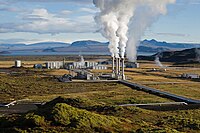
Photo from wikipedia
Abstract Commercial panelized rainscreen facade systems have gained in popularity in the United States and Europe over the last 10 years. These systems are characterized by external subframe support structures… Click to show full abstract
Abstract Commercial panelized rainscreen facade systems have gained in popularity in the United States and Europe over the last 10 years. These systems are characterized by external subframe support structures which exist within the ventilated cavity of the assembly and utilized various bracketed or girted frames with multiple point support fastenings through the building envelope. Given the popularity of these systems and the increasing mandates for higher performing envelopes – subframe applications and products which increase thermal resistance and decrease thermal bridging are becoming more prevalent. This research will compare four common subframe assemblies based on annual source energy output for a mid-size office building. The assemblies will be simulated in all eight ASHRAE climate zones to provide comparative analysis per assembly and exterior environment. Accurate assessment of a wall assemblies thermal performance requires its cumulative Y-value contribution based on the total envelope area, detailed transitions, and material construction. The inclusion of specific value inputs for non-repeating linear and repeating point thermal bridging conditions provide a more accurate perspective into building energy efficiency and its relationship to envelope performance for all wall types analyzed. This method of thermal simulation and evaluation is necessary for accurate envelope and building performance analysis.
Journal Title: Energy and Buildings
Year Published: 2019
Link to full text (if available)
Share on Social Media: Sign Up to like & get
recommendations!